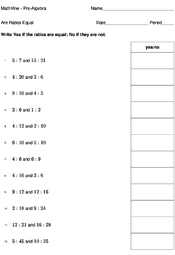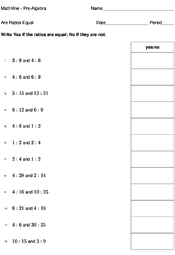Determine if Ratios are Equal
Introduction
Ratios are a useful way to show how two values relate to one another. For example, if you are about to cycle up a hill with a ratio of 1:5, for every yard five yards you travel horizontally, you will have gained a yard in height. A soccer team with a 2:5 win ratio will win two games out of every five played. By showing these ratios, we can easily extrapolate a lot of information (for example, if the team played 10 games or 15 games, we could quickly determine how many they won).
If you get two sets of ratios, you can compare them and determine if they are equal. For example, if another soccer team in the same division had a win ratio of 4:9, we can work out if they win more than the team with the 2:5 ratio.
Terms
Lesson
To find if ratios are equal, we need to find a common number. to do so, we need to find a common factor of both.
Using the examples in the introduction above, we have two soccer teams:
Team A has a win ratio of 2:5 (i.e. it wins 2 games out of every 5 that it plays)
Team B has a win ratio of 4:9 (i.e. it wins 4 games out of every 9 that it plays)
It's easier if we compare the second number in the ratio since that's the number of games played. We need to find a common factor of 5 and 9.
To find a common factor we can compare the multiples in the table below
| 5 | 9 | |
|---|---|---|
| x1 | 5 | 9 |
| x2 | 10 | 18 |
| x3 | 15 | 27 |
| x4 | 20 | 36 |
| x5 | 25 | 45 |
| x6 | 30 | 54 |
| x7 | 35 | 63 |
| x8 | 40 | 72 |
| x9 | 45 | 81 |
Therefore, 45 is the lowest common factor.
Now we need to set Team A’s ratio to 45. To do that, we need to multiply both parts by 9.
So, if Team A were to play 45 games, it would win 18.
For Team B, we need to multiply both sides of the ratio by 5.
So, if Team B were to play 45 games, it would win 20.
Therefore, Team B has a slightly better win ratio. By setting the terms, we can directly compare if they are equal or not.


